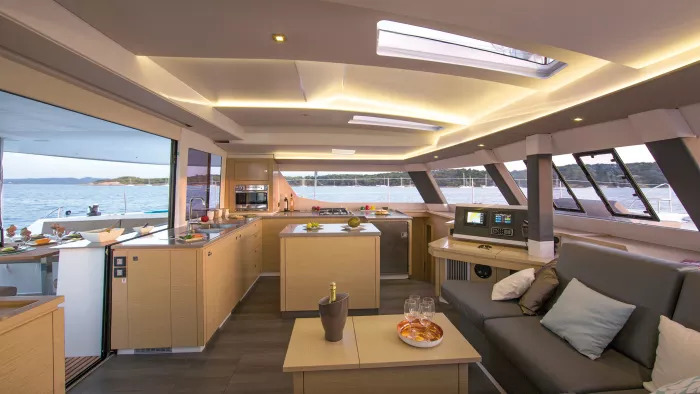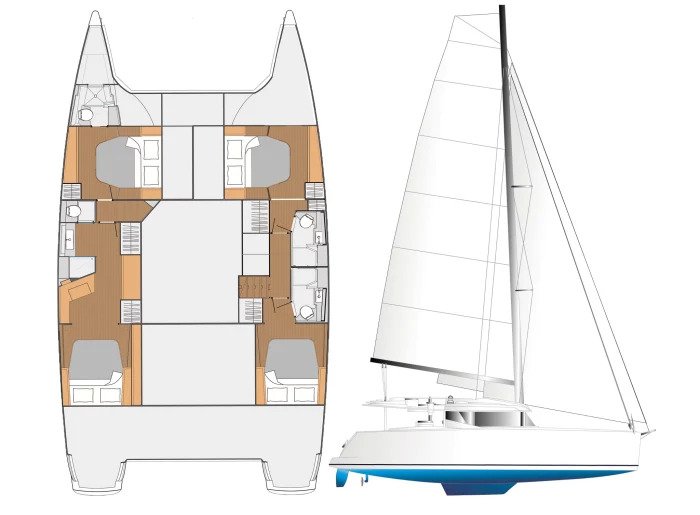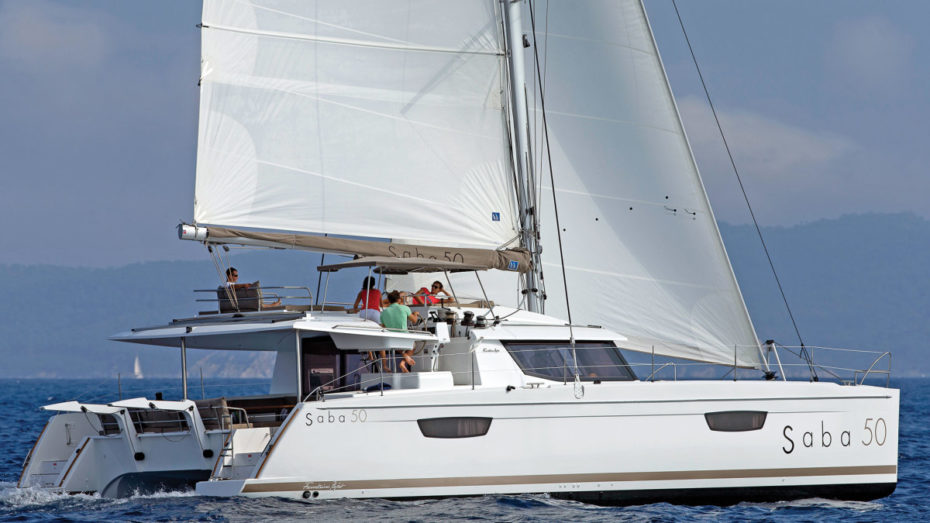With the new Saba 50, Fountaine Pajot has optimized livability and comfort both inside and out. Multiple groups of people can socialize in segregated outdoor spaces, while the interior accommodations would put some hotels to shame.
Design & Construction
Despite the boat’s size, designers Berret Racoupeau have worked hard to make it not only sail well, but remain easy to handle. The hulls, for example, have been given a fine entry for better performance, and a pair of fixed keels help the boat sail to weather. The focus in construction methods is on making the boat strong but light, with a vacuum-bagged PVC-foam-core laminate. Resin Transfer Molding (RTM) produces the whole deck and cabin as one piece with both sides sprayed with gelcoat for a finished look. The chainplates are integrated into the hull structure and are strong enough that the whole weight of the boat can be lifted on them.
On Deck
With so much deck space on the Saba 50, Fountaine Pajot was able to create three distinct and relatively separate social areas. The first is at the bow, where a conversation nook includes two lounges with accompanying settees and a cocktail table. Eight people can easily gather here for sundowners and enjoy the shade of the cabinhouse instead of baking in the aft cockpit. It’s a very civilized space that still leaves room for lounging in the trampoline but adds a superyacht feel.On the other end is the aft cockpit, which is two steps up from a swim platform on either hull. A long straight transom seat for six to eight people fronts the davits, which can hoist a 14ft dinghy. To port is the main dining table that seats six when folded, but also extends back to that great transom seat so a total of 10 people can be invited to dinner. An additional lounge is to starboard. A hardtop targa roof extends back over most of the cockpit, stopping just short of the transom seat so you can catch some sun if you like.
On the other end is the aft cockpit, which is two steps up from a swim platform on either hull. A long straight transom seat for six to eight people fronts the davits, which can hoist a 14ft dinghy. To port is the main dining table that seats six when folded, but also extends back to that great transom seat so a total of 10 people can be invited to dinner. An additional lounge is to starboard. A hardtop targa roof extends back over most of the cockpit, stopping just short of the transom seat so you can catch some sun if you like.
Step up to the “flybridge” and there are three sun lounges and an additional settee to make another six people comfortable. The view is fantastic, and everyone can converse with the captain without getting in the way, because the separate helm is two steps down to starboard. The helm pod has a double seat and houses Raymarine electronic displays, engine controls and wheel.
The winches are ahead and apart from the wheel so that anyone managing sails has room to work without getting in the way of the helmsperson. For singlehanding, the autopilot will come in handy as you must stand ahead of the wheel to reach the winches. One item here that can be improved is that there is no direct access to the side deck from the helm. Instead, you have to walk around the wheel and out, which adds another five steps. A simple modification would fix this so that the helmsperson can more easily manage lines when docking.
Accommodations
The Saba 50 is available in owner’s or charter versions, so you can limit your company or really pack the boat with family and friends. Unlike most catamarans, the Maestro, or owner’s version, comes with four cabins rather than the standard three, as Fountaine Pajot has made innovative use of the boat’s interior.

The saloon transitions seamlessly into the cockpit, creating a large social area
The master stateroom aft features a large island berth, a small desk and enough storage space to rival a New York City apartment. The head is really a bathroom, like you’d find in a Marriott, with a sink between the toilet and shower compartments. This cabin takes up about three-quarters of the port hull, which still leaves room for a full guest cabin and ensuite head forward. The starboard hull has two large cabins and ensuite heads.If you’re looking for more staterooms, the Quintet (charter) version shoehorns three cabins into the port hull and three to starboard. Quintet implies that there are only five cabins, but that’s because Fountaine Pajot reserves the middle starboard cabin for crew and doesn’t really count it as guest accommodations. That having been said, with its own head and midship placement, it is fairly posh and could still serve guests well.
If you’re looking for more staterooms, the Quintet (charter) version shoehorns three cabins into the port hull and three to starboard. Quintet implies that there are only five cabins, but that’s because Fountaine Pajot reserves the middle starboard cabin for crew and doesn’t really count it as guest accommodations. That having been said, with its own head and midship placement, it is fairly posh and could still serve guests well.The social area on the main deck has a galley that would make even a land-dweller jealous. The large double-drawer refrigerator is easily accessed, and a center island means multiple people can participate in meal preparation. A four-burner stove and a freezer are outboard, and an oven sits up at counter level. A sliding window next to the sink means meals can be passed directly from the galley to the cockpit, which is ideal since Fountaine Pajot recognizes that most of the dining aboard catamarans takes place al fresco. With this in mind, the main dinette is the one in the aft cockpit, leaving a low settee and accompanying coffee table (with integrated wine bottle storage) to grace the saloon. The settee seat does double duty as a seat for the fully-featured interior navigation station.
The social area on the main deck has a galley that would make even a land-dweller jealous. The large double-drawer refrigerator is easily accessed, and a center island means multiple people can participate in meal preparation. A four-burner stove and a freezer are outboard, and an oven sits up at counter level. A sliding window next to the sink means meals can be passed directly from the galley to the cockpit, which is ideal since Fountaine Pajot recognizes that most of the dining aboard catamarans takes place al fresco. With this in mind, the main dinette is the one in the aft cockpit, leaving a low settee and accompanying coffee table (with integrated wine bottle storage) to grace the saloon. The settee seat does double duty as a seat for the fully-featured interior navigation station.
A wide glass door separates the outside from the inside, but the two are on the same level so it’s easy to move from the exterior to the interior. Natural light floods through overhead hatches and large windows that you can see out of even when seated.
Under Sail
Test day on the Chesapeake was one of those rare days that boat reviewers pray for. We cast off on a sunny morning with winds of 15 to 17 knots and were eager to get out on the flat waters of the bay. We hoisted sails faster than expected as we soon discovered that the port prop had been fouled the day before by a heavy dock line. No matter, it was time to go sailing.
After the 899ft² mainsail was raised with the help of the electric winch, we gained enough steerage to shut down the engines completely. At a 60-degree apparent wind angle, we were moving at 4.6 knots under main only. Once out in open bay, company representative Romain Motteau unfurled the 619ft² genoa and our speed increased to 9.2 knots in 17 knots of breeze. Pointing a little higher, our speed dropped to 5.8 knots, but easing off to a nice beam reach it picked up to 10.3 knots again. Our top speed that day was 14.6 knots at a 120-degree AWA, which was a nice ride. Still, it was the upwind performance that really got my attention. Cruising catamarans aren’t known for their pointing ability, but here was a large—and I mean large—cruising cat doing 6 to 9 knots with the wind ahead of the beam. Again, despite its size, this boat is still a sailer.
Under Power
The Saba 50 comes standard with 55hp Volvo Penta D2 diesels with saildrives, but our test boat had been upgraded with the optional 75hp units. Three or four-blade fixed or folding props are available.
Although docking the 26ft-wide boat in a beam wind with only one engine was exciting, it remained quite manageable, a testament to the Saba 50’s well-behaved demeanour, even in tight quarters with an awkward spot to tie up.
Conclusion
The Saba 50 is a well-thought-out boat that feels substantially bigger than its LOA. The thing that struck me most, however, was that a cruising cat of these dimensions can actually sail to weather, and quite impressively at that.

Layout and Sail plan
Images courtesy of Fountaine Pajot; sailplan by Pip Hurn
More details and photos can be found on the shipyard’s website www.catamarans-foutain-pajot.com or contact fountaine-pajot@fountaine-pajot.com
Source: Boat Review: Fountaine Pajot Saba 50 – Sail Magazine

